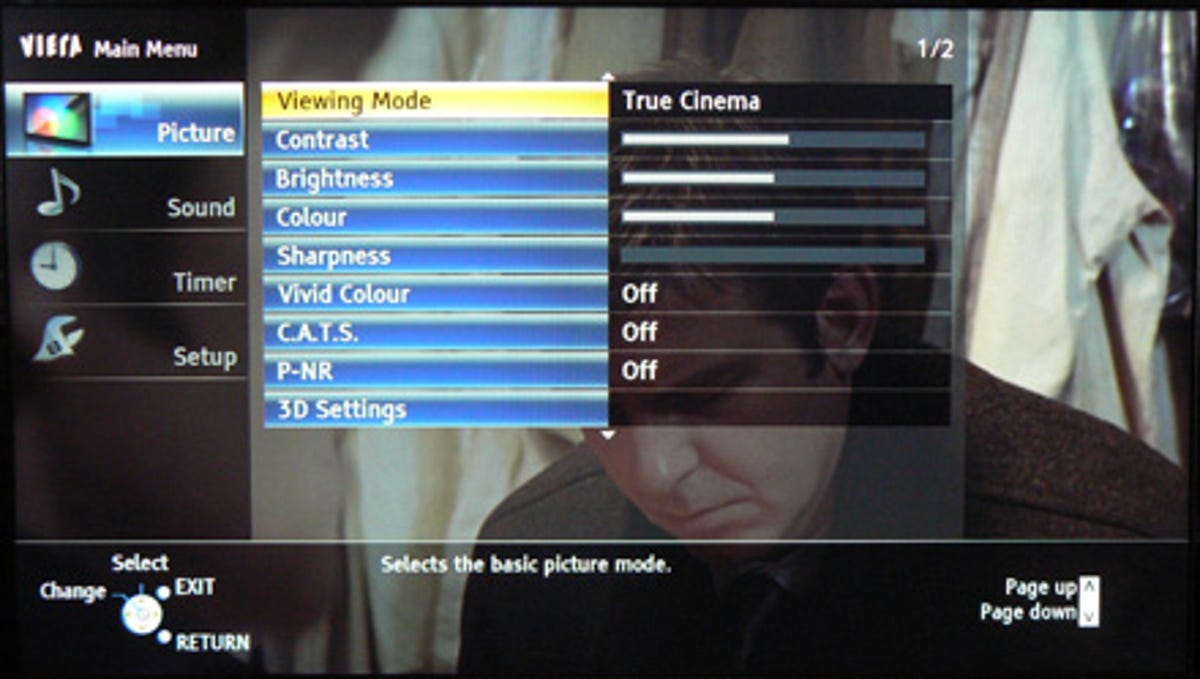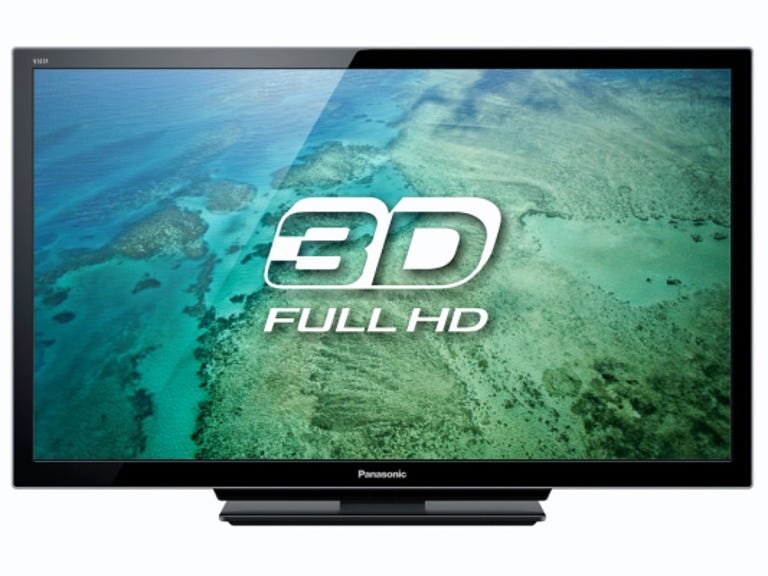 Why You Can Trust CNET
Why You Can Trust CNET Panasonic Viera DT30 (TX-L37DT30B) review: Panasonic Viera DT30 (TX-L37DT30B)
The Panasonic Viera TX-L37DT30B is a great LED TV, offering excellent 3D performance, punchy 2D pictures and a good line-up of Internet services. It's expensive for a 37-inch TV, though.
Many of the active-shutter 3D LCD TVs currently on the market suffer quite badly from crosstalk, or double imaging, when displaying 3D movies. It's one of the reasons why plasmas have often been the best option for those interested in an active-shutter 3D telly.
The Good
The Bad
The Bottom Line
But Panasonic thinks it's solved the problem with its 37-inch, 1080p, LED-illuminated Viera TX-L37DT30B, which is available for around £800 online. This LCD TV features a panel with a particularly fast response time, which the company says largely eradicates the crosstalk issue. We took a closer look to test out the company's claims.
User interface and EPG
Panasonic's TVs have been stuck in something of a time warp when it comes to their menu systems, and the TX-L37DT30B is no exception. While other companies use flashier menus that offer smooth transitions, slick animations and a generally more dynamic feel, Panasonic has merely added the odd icon here and there to its distinctly old-school offerings.
Basically, what you get are endless, static menus that show white text on a blue background. There are no animations, very few icons and a minimal amount of colour. It really is time for Panasonic to up its game in this area if it wants to keep pace with its rivals.
Nevertheless, the menu system is logically laid out and it's pretty easy to find your way around. Hitting the menu buttons lets you quickly flick between picture and sound controls, for example, and the picture menus offer pretty comprehensive control over not just colour and contrast but also picture-processing features such as the Intelligent Frame Creation and upscaling modes.

We're not remotely chuffed by Panasonic's decision to stick with the Guide Plus+ system for this set's electronic programme guide. It really is a mess, mostly because it reserves space on the left-hand side of the screen for Web-style adverts. This compromises the amount of space available to show programming information.
The presentation of the EPG is quite dull too, and we don't like the way it completely obscures the channel you're watching. It'd be better if it reduced the current channel to a video box in the corner of the EPG, as most other TVs do. At least the EPG is quite fast, partly because the graphics are so basic.
Digital media and Internet features
The TX-L37DT30B is no slouch when it comes to digital-media playback and Internet features. The set has three USB ports, as well as an Ethernet jack and an SD card slot. The idea behind the three USB ports is that you can have a hard drive connected to one, an optional wireless adaptor plugged into another, and keep the third port free for hooking up USB keys every now and again.
If you connect a hard drive to the USB port marked with the HDD symbol, you can record shows from the Freeview HD or freesat HD tuners directly to disk. Shows can be recorded either by hitting the record button on the remote as you're watching a channel, or setting up a timed recording via the EPG. Although the set has two tuners, you can only record from one channel at a time, and you can't record one channel while watching another, as you can with twin-tuner PVRs.
The TV also supports playback of media files from hard drives or memory keys plugged into the other two ports. Format support is good. Along with the usual JPEG picture and MP3 music formats, it also works with Xvid files and even high-definition MKV videos. The TV will happily stream these digital media files across a network via its Ethernet port too, and we had no problem getting it to work with the Universal Plug and Play server built into our Iomega network-attached storage drive.
Like most other manufacturers, Panasonic has embraced Internet video. Call up the Viera Connect menu and you'll find a decent range of Web video services, such as BBC iPlayer, YouTube, Acetrax and Dailymotion. There are also apps for Facebook and Twitter, as well as support for Skype.
There's even an app store in which you'll find loads of simple games, as well as apps for a number of news and information services, such as AccuWeather and Euronews. All in all, it's a pretty good showing on the online front, although the Viera Connect interface can feel rather slow and clunky at times.
Design and connections
Panasonic has started to take the design of its sets rather more seriously. The TX-L37DT30B is certainly much more attractive than last year's models. The glossy finish and thin metallic strip that frames the entire set help to give it a more upmarket feel.
You won't be stuck for ports when it comes to hooking up your high-definition gear either, as there are four HDMI inputs on offer, alongside the usual set of component inputs and the Scart socket. One HDMI port also supports 'audio return channel', so you can route audio to an external surround-sound system. Other connections include a composite input, as well as a VGA socket.
Audio quality
When it comes to audio, LED sets present a major problem for manufacturers. A super-slim chassis simply doesn't leave much room for a speaker driver, and the upshot is that most LED TVs sound thin and weedy.
Panasonic takes an unusual approach to this problem. The TX-L37DT30B's panel is quite slim, at 33mm thick, but it flares out near the bottom to 72mm, so there's space for larger speakers. It's a clever tactic, because the set still looks uber-slim, but its audio is much beefier than that of most rival sets.
If you tweak the audio appropriately using the set's graphic equaliser, the TV will deliver full-bodied bass that adds extra kick to music channels like 4Music. Dialogue in movies and TV dramas is also firmly embedded into the mix, while action movies still manage to sound suitably bombastic. All told, it's one of the better-sounding LED models we've come across.
3D picture quality
The big selling point of this TV is its 3D capability, which also accounts for its relatively high price tag. The advances Panasonic has made in this area centre around the panel. This set uses a redesigned IPS-Alpha panel that has been tweaked to provide a much faster response time than previous panels. To achieve this, Panasonic has had to push the LED backlight closer to the panel surface and also use a new type of liquid crystal that's more fluid than before.
The upshot of all this is that Panasonic believes it's increased the response time by around 50 per cent. But the company hasn't stopped there. This TV also has 400Hz processing, which comes courtesy of a 200Hz refresh rate that works in conjunction with a scanning backlight.
The good news is that all these innovations really do shine through in this set's 3D performance. We really were hard-pressed to notice any crosstalk. In fact, we think this TV's performance is up there with that of some of the best 3D plasmas. In some ways, it actually surpasses them, mainly due to the fact that it produces brighter images thanks to its LED backlight. This, in turn, helps to reduce the dimming effect of the 3D glasses. As a result, colours look much punchier on this set than they do on most of Panasonic's own 3D plasmas when you've got active-shutter specs on.
The bad news is that the set doesn't come with any glasses. These glasses are quite expensive, at around £80, and they're heavy too, so they can be uncomfortable. The high price tag of the specs means that those with a large brood might be better off opting for one of LG's passive 3D TVs -- the glasses for those sets are as cheap as chips, at around just £2 each.
2D picture quality
The bright and punchy nature of the 3D pictures carries over to the set's 2D images. Panasonic seems to have tweaked its preset to provide slightly warmer and more cinematic colours that are ideal for watching movies.
Black levels are also very good, but, as the set uses LED dimming to help produce the black levels, you do occasionally see haloing in movies where there are very bright or white objects set against a dark or black background. It's not a massive issue, but some people will find it annoying.
The set's sharpness can't be faulted, though, as hi-def sources look fantastically crisp. The upscaling engine also works exceedingly well. Upscaled standard-definition pictures display good levels of sharpness, but don't suffer from tonnes of added image noise.
Conclusion
The Panasonic Viera TX-L37DT30B is a cracking TV. It's one of the first LCD sets that shows the technology can seriously compete with plasma when it comes to producing crosstalk-free 3D images. It also offers impressive 2D performance and a good line-up of Internet and media-streaming features.
It's just a shame the excellent 3D performance comes at quite a high price, especially considering the screen's small size. We also can't help feeling that larger families would be better off with a passive set like LG's impressive 42LW550T.
Edited by Charles Kloet


